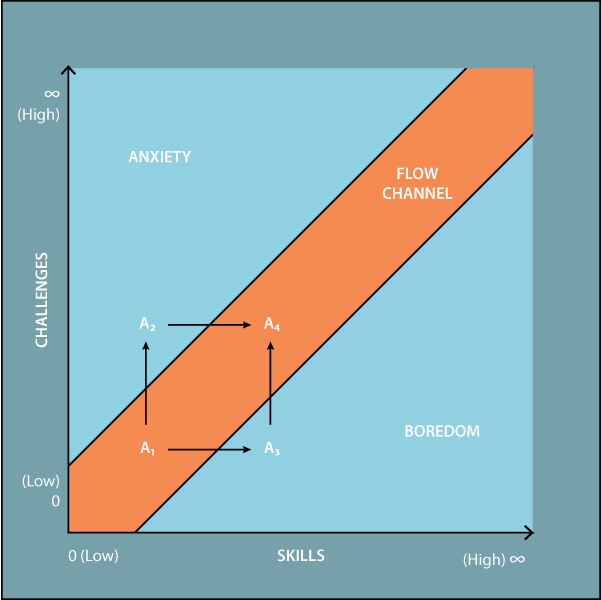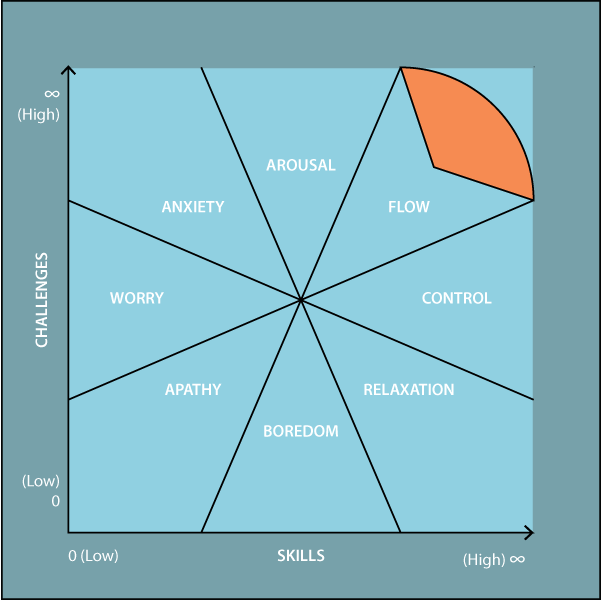On Flow and Flow Control: How to Design Games for Player Growth, Replay Value, and Great Gaming Experiences
17.01.2017
In game design, not everything revolves around interactivity. But interactivity is certainly an essential element that a game has to get right in order to be a great game, and to get interactivity right, the player has to be presented with the “just-right” amount of challenge.
It’s the Goldilocks principle, effectively, and the best descriptor for this right amount of challenge, a challenge that is neither too hard nor too easy, is the concept of flow, originally developed in the 1970s by the psychologist Csíkszentmihályi Mihály and subsequently expanded upon by himself and others.
For everybody who’s read more than zero books on game design, chances are they’ve seen a version of the following diagram before:
The illustration is adapted from Csíkszentmihályi Mihály’s own illustration in Flow: The Psychology of Optimal Experience. At first glance, not much needs to be said about it, but its familiarity is deceiving—it’s way more interesting in its original context. To start with, and to get that out of the way quickly, the often foregrounded “becoming oblivious of time” aspect is both a benefit and a supporting factor, but that’s it. It's not at the heart of the matter.
So what is flow about? The letter “A” in the illustration represents “Alex,” who is learning to play a game (tennis, in this case), and Alex wants to avoid both anxiety and boredom because neither are positive experiences. To avoid these negative experiences, Alex’s only available choice (barring the decision to quit playing altogether) is to return to the flow state—thus, Alex, and any other player likewise, is highly motivated to do just that.
And this is important because game designers won’t have to (or shouldn’t) design games in such a way as to perpetually analyze the player’s performance and try to wrap the flow channel around them, so to speak. Instead, they should follow two related design principles.
The first design principle is to provide well-crafted tiers of challenges (so players can pick their appropriate difficulty levels), the second is to provide a well-crafted range of options to meet these challenges (so players can pick a mechanic that suits their current skill sets and personal preferences). From there, the player will do the rest because they’re highly motivated to stay, or get back into, their flow state.
Obviously, these design principles will also give players significantly more freedom in creating their own experiences. (The game may help them along with a little Dynamic Difficulty Adjustment, but DDA contributes its own colorful problems.) These dynamics, furthermore, inevitably lead to growth and discovery because—to stay within the flow channel—players must a) constantly improve their skills and b) constantly explore new opportunities for putting their improved skills to use.
And that’s the reason why, according to Csíkszentmihályi, the experience of flow is always related to growth, and not just any old growth, but growth of the self.
So much for the flow channel as such, but where do players go when they leave it? That depends on their respective skill/challenge ratio. There's an illustration for that, too:
This illustration again is adapted from an illustration by Csíkszentmihályi Mihály, this time from Finding Flow: Psychology of Engagement with Everyday Life, which was in turn adapted by Csíkszentmihályi from Fausto Massimini & Massimo Carli’s “The Systematic Assessment of Flow in Daily Experience.”
It shows flow within a Cartesian coordinate system of positive and negative experiences, where again the magnitude of “Challenge” constitutes the vertical and the magnitude of “Skill” the horizontal axis. Once more, flow is achieved when the values for Skill and Challenge are correspondingly high.
If Challenge increases more than Skill, the player (or performer, but let’s stick with “player” for the purpose of game design) will leave the flow state toward “Arousal,” “Anxiety,” or “Worry,” depending on current skill levels. If Skill increases more than Challenge, the player will leave the “Flow” state toward “Control,” “Relaxation,” or “Boredom,” depending on current challenge levels. At the lower end of both skill and challenge levels, players will fall back to “Apathy.”
Interestingly, in earlier versions of this model before 1988, the placement of “Relaxation” and “Boredom” was reversed. This was an initial hypothesis that intuitively made sense: without sufficient challenge, players at higher skill levels should be more easily bored than players at lower skill levels. Empirically, this didn’t turn out to be true at all. A good number of studies since then have showed that, when players are not sufficiently challenged, boredom is more likely to occur at lower skill levels while players with higher skill levels tend to fall back to a “relaxed” state when challenge decreases. While not as intuitive as the original hypothesis, it better matches the data. (And personal experience as well.)
The takeaway is to bake into a game’s core challenges the highest possible degree of scalability, so the player can match their current skill level with the appropriate level of challenge and with the appropriate mechanic to meet that challenge, both of which keeps the player motivated to constantly push forward and stay within their flow channel.
How can that be accomplished? The general principle to put players in control of their flow channels is to design the game’s challenge structure in a way that concurrently escalates risk, relief, and reward, and not just over time, but “stacked” at any given gameplay moment. Is the player willing to jump down that suspiciously steep manhole for some loot or rare power-up, and risk falling into toxic sludge instead of hitting that preposterous excuse of a footway? Greater risks that experienced players are willing to take are met by greater relief, i. e., more opportunities to restock staples like health, ammo, and so on, and greater rewards of any kind, from loot to experience points.
This applies to interactive mechanics as well. Here, it means providing an interesting variety of interactive mechanics with different levels of difficulty, among which the player can choose according to skill, or whim.
This design principle can be seen at work in many games, with numerous imaginative variations. Especially, it’s what makes Mario and similar games so enjoyable for players with widely differing experience and expertise. At every single moment of the game, they provide choice—about the preferred level of challenge and the preferred means to meet that challenge.
Which puts players in control of their own flow channels, and on the track for great gaming experiences with high replay values and opportunities for personal growth.
Illustrations
Adapted illustrations CC BY-NC-SA 4.0 by
J. Martin | betweendrafts.com | ludotronics.net
Sources
Csikszentmihalyi, Mihaly. Flow: The Psychology of Optimal Experience. New York: Harper & Row, 1990. 74.
Csikszentmihalyi, Mihaly. Finding Flow: Psychology of Engagement with Everyday Life. New York: Basic, 1997. 31.
Massimini, Fausto & Massimo Carli. “The Systematic Assessment of Flow in Daily Experience.” In: Optimal Experience: Psychological Studies of Flow in Consciousness. Ed. Mihaly Csikszentmihalyi & Isabella Selega Csikszentmihalyi. New York: Cambridge UP, 1988. 266–87. 270.


